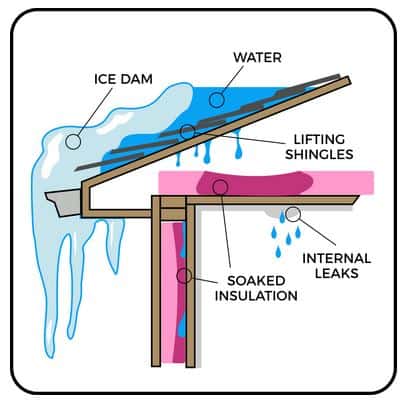
Ice Dam Prevention, Removal, and Repair: Everything You Need to Know
An ice dam can form on any roof when snowy or icy conditions occur, leading to significant damage if left unchecked. The good news is that with proper prevention and timely action, you can protect your home from the costly effects of ice dams. Understanding what ice dams are, how they form, and how to deal with them is the first step in safeguarding your property.
What Is An Ice Dam?

Ice dams occur when snow or ice melts unevenly on your roof due to inconsistent heating. Factors like heat escaping from the home, sunlight exposure, and shading from trees or nearby structures can create uneven roof temperatures. As a result, melted snow flows down the roof and refreezes in colder areas, forming thick ice that traps water behind it.
This trapped water can pool and seep under roofing materials, causing leaks and water damage. Ice dams also put extra weight and pressure on gutters, fascia, and soffits, leading to potential structural damage. If left unaddressed, an ice dam can result in costly repairs for homeowners.
.
How to Prevent Ice Dams
The key to preventing ice dams is maintaining a cold, evenly heated roof surface. Here are some effective strategies to protect your home:
- Improve Attic Insulation: Ensure your attic is well-insulated to minimize heat escaping through the roof. High-quality insulation distributed evenly is crucial.
- Enhance Ventilation: Proper attic ventilation helps regulate roof temperature by improving airflow.
- Seal Gaps: Check for air leaks around chimneys, vents, and other roof openings, and seal them to prevent warm air from escaping.
- Trim Nearby Trees: Overhanging branches can create shaded areas, leading to uneven melting. Trim trees before winter to maintain even roof exposure to sunlight.
Taking these preventive steps before the cold weather sets in can save you from ice dam-related headaches during the winter.
Safe Ice Dam Removal Techniques
If an ice dam forms, avoid using sharp tools like ice picks, as they can damage your roof. Instead, try these safer and more effective methods:
- Use a Roof Rake: Specially designed rakes can safely remove snow from the roof and reduce the risk of ice dam formation.
- Apply Deicers: Products like calcium chloride can help melt ice dams. For easy application, place the deicer in a nylon stocking and position it on the ice dam.
- Increase Air Circulation: Place a box fan in the attic to help cool down hot spots on the roof.
Avoid using salt, as it can harm your landscaping and vegetation when it falls from the roof.
Dealing with Water Damage from Ice Dams
If you remove an ice dam quickly, you may not have to deal with the effects of water damage from a roof leak. However, if you are like many others, you may not realize that an ice dam has formed until it is too late. Insurcomm is your leading
 source for water damage repair from ice dams and other issues throughout New England. We provide our clients with a fast response and effective remediation and restoration services. Water damage may become more problematic over time, so it is best to address this issue head-on.
source for water damage repair from ice dams and other issues throughout New England. We provide our clients with a fast response and effective remediation and restoration services. Water damage may become more problematic over time, so it is best to address this issue head-on.
The best time to prepare for an ice dam is well before cold winter weather arrives. Spending time improving ventilation, and insulation throughout the attic and pruning tree branches are essential before each winter season arrives. You also need to be observant throughout the winter so that you can take pre-emptive steps if an ice dam begins to form. Reach out to Insurcomm immediately for restoration services if your home is damaged by water.
Ice Dam Prevention: Prepare Your Home Before Winter
Ice dam damage can be costly, but preparation is your best defense. By taking proactive steps before the winter season, you can protect your home from the risks of ice dams.
How to Prevent Ice Dam Damage
Follow these essential tips to safeguard your roof:
- Enhance Roof Insulation: Proper insulation minimizes heat loss, preventing uneven roof temperatures that cause ice dams.
- Improve Attic Ventilation: Ventilation helps regulate roof temperature and reduces the chance of ice dam formation.
- Trim Overhanging Branches: Prune tree branches that create shaded areas on your roof to ensure even melting of snow.
What to Do If Ice Dam Damage Occurs
If an ice dam has already formed and caused water damage, it’s crucial to act quickly. Insurcomm specializes in water damage repair and restoration for homes throughout New England. Our team provides fast, effective solutions to restore your property.
Contact Insurcomm for Ice Dam Damage Repair
Don’t let an ice dam compromise the safety of your home. Contact Insurcomm, New England’s leader in ice dam damage repair and restoration services, to protect your property this winter.
